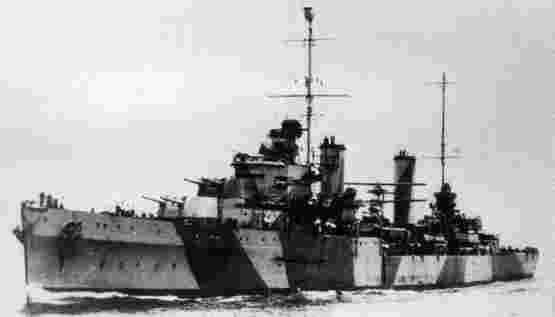- Author
- Mearns, David L and Captain Peter Hore, RN
- Subjects
- RAN operations, WWII operations
- Tags
-
- RAN Ships
- HMAS Sydney II
- Publication
- December 2003 edition of the Naval Historical Review (all rights reserved)
FOR SIXTY YEARS a copy of Captain Theodor Detmers’ Gefechtsbericht or action report of the fight between his ship, the German raider Kormoran, and the Australian cruiser Sydney in November 1941 has lain hidden in a dictionary. Detmers kept this dictionary throughout his captivity in Australia and brought it home to Germany: it has now been fully transcribed and translated.

The dictionary account, which was briefly examined by Barbara Winter in the early 1990s, is written by dots under letters, within the German-English part of a two volume dictionary published by Cassell and Co in December 1939 in London, Toronto, Melbourne and Sydney. The dots are barely visible to the naked eye until one’s attention is drawn to them. How the dictionary came into Detmers’ possession is not known, but it is not damaged by seawater as might be expected if it had been in the lifeboats with the Germans after they abandoned Kormoran.
Though the pages are yellowed with age the dictionary is in good condition: it is tightly bound, the spine is not worn or broken, and the pages are not thumbed or dog-eared, suggesting that it was carefully preserved. Further, the dots are excessively difficult to read and transcribe. Other evidence indicates that this account was probably dotted into the dictionary in early 1942 after Detmers was reunited with his officers in the Dhurringile prisoner of war camp. Clearly this was a reference copy rather than a working copy of the deck log, and other versions like the 1945 coded and 1947 typed versions were written by reference to a parent document, and this may have been the deck log itself.
Another copy of Detmers’ action report, which has been disregarded since 1947, is among documents rediscovered this year in the basement of the Admiralty Library in London, and posted on the Royal Australian Navy’s Sea Power Centre website. The 1947 report was confiscated from Kormoran’s survivors when they arrived in Cuxhaven onboard the steamer Orontes and is described as ‘Report of the action on the 19th Nov. ‘41’. At first glance this two page document seems just another copy of the log book and engine room log of the Kormoran whose provenance is the 1945 coded copy which Detmers took with him on his escape, but there are significant differences in detail.
Previously the best known German account of the battle was the one found in code on Detmers after his escape from prisoner of war camp. When Detmers was recaptured he was carrying a document in code, which is sometimes described as a diary but in fact was a notebook. In its most complete and earliest form in the Australian Archives, the document consists of a covering letter, two pages of cryptographic worksheets, and 15 pages of the cypher and its corresponding German plain language text (the actual notebook containing the coded account appears no longer to exist). ((Australian Archives (VIC) B5823/1: Dietmar’s (sic) Diary – Account of Action between Kormoran and Sydney, Decode and Translations. This is subtitled: Folder of Papers Contained Encrypted, German Plain- Text and Translated English Version of the Deck Log and the Engine Room Log of HSK Kormoran.)) Page one of the cypher is missing, but there are two manuscript translations upon which a number of subsequent typed versions are based. ((Australian Archives Guide No 3: The Sinking of HMAS Sydney, a Guide to Commonwealth Government Records, January 1997. Page 95.)) A close reading of these pages and comparison with other accounts reveals that the process of encryption, decryption, translation and typing had led to errors. In order to make an accurate comparison, the coded version has been freshly decrypted and translated, and allows the authors of this paper to reveal errors which have misled historians for many years.
For example: the first attempt at translating ‘Segler in Sicht BB voraus Peilung etwa 20 rw’ gives ‘Sailing vessel in sight on port bow bearing about 20 south-west’. However, ‘rw’ is the German abbreviation for ‘rechtweisend’ meaning ‘true bearing’, thus the correct translation should be ‘Sailing vessel in sight on port bow bearing about 020 True’.
Similarly the German plain language ‘Auf V-Mann Weg gegangen’ is in some versions not translated or ‘VMANNWEG’ is held to be a corruption (see Table 1 below). In fact ‘V-Mann’ is the German military abbreviation for ‘Vertrauensmann’ meaning an ‘informant’ or a ‘trusted source’. Examination of other references makes it clear that Detmers was referring obliquely to a message received from the German radio monitoring service known as the B-Dienst.
|
The Dictionary version |
The Coded version captured from Detmers in 1945 |
The Typed version confiscated in 1947 |
| 811 | 8.11.41 | |
| Alterations [to engines] completed.Test run without incident. Proceeding on information received [from B-Dienst]. | Trial run without trouble. Proceeded to (VMANNWEG?), as still time left till new moon. | Alterations [to engines] completed.Test run without incident. Proceeding on information received [from B-Dienst]. |
| Will by [the] new Moon be off Perth. | Shall then be off Perth. | Will by (the) new Moon be off Perth |
| Information from [PP = d/f?] ((The meaning of ‘PP’ has not been clarified.)) about Cornwall with comvoi [sic] off Cape Lewin [sic] [on] westerly course, therefore turned towards the North East. | Report of Cornwall with convoy off Cape Leeuwin on westerly course. Thereupon set course north-east. | Information about Cornwall with convoy off Cape Leuwin [sic] [on] westerly course, therefore turned towards the North East. |
| Intention to survey the coast off Sharkec [sic] Bay. | Intention: investigation of coast off Sharks Bay. | Intention to survey the coast off Sharks Bay. |
Table 1




